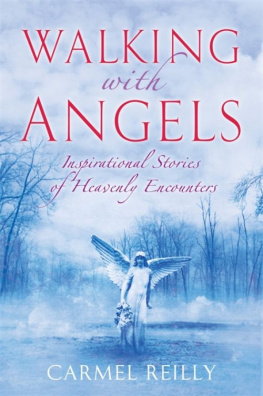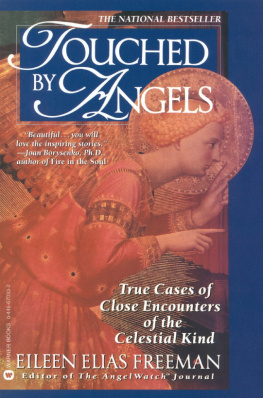Randy, a fireman, was called in for a four-alarmer. He raced to his car, jumped in and turned the key in the ignition. Then he heard a voice say, Stop!
He looked around. There was no one there. Then he heard it again. Get out of the car.
Randy pushed open the door and walked to the rear of the car. And stopped, stunned. Little Marie Puckett was sitting on the ground, her back resting against his back bumper, happily playing with a shovel as she was digging dirt and scooping it into a small bucket. Hi, Uncle Randy, she said.
He hadnt heard her playing behind his car. He had been about to back the car out of the driveway, whenhe heard a voice that spoke to him as clearly as anyone ever had but there was no one there!
A NGELS
A MONG U S
DON FEARHEILEY

Dedicated
to
TEENIE
Who taught me the most about angels
Contents
Everyone knows about angels, at least at the level of sentiment. Greeting cards, songs, and poems portray the goodness, purity, and love inherent in an angel, applying these qualities to sweetheart or spouse.
But are angels real?
For most people this question revolves around how they view the Bible. The Bible says that Abraham, Jacob, Moses, Joshua, Gideon, David, Elijah, Zacariah, Joseph, Mary, and Peter all saw angels. Three angels were actually mentioned by nameMichael, Gabriel, and Raphael. Michael was mentioned in three books: in Daniel he is described as the great prince charged to defend the people of God; in Jude he is seen as the archangel fighting with Satan over the body of Moses; and in Revelation he is shown leading his angels against the dragon. Tradition has Gabriel presiding over paradise, and according to Mohammed, Gabriel was the angel who at Gods command dictated the Koran. Raphael is considered the guardian angel of science and knowledge, the healer of disease.
Passing time built the traditions of other angels. Medievel Jewish scholars declared there were 301,655,722 angels. Gustav Davidson took a more limited approach in his A Dictionary of Angels. Drawing names from the Bible, rabbinical and cabalistic literature, writings of the church fathers, and poetry, he fashioned brief biographies of 3,406 angels. Some of these angels had an elevated purpose, like Uriel, archangel of salvation, often credited with warning Noah of the flood. But other angels liked to play pranks, as did Baltazard.
No one knew how angels looked, but by the fourth century A.D . artists conceived them with wings. Were they male or female? Another heated question. But in A.D. 1272 Thomas Aquinas reasoned that angels could assume whatever aspect they desired, and were therefore neither male nor female. Luther and Calvin both believed in angels, but Luther prayed that God would not allow angels to enter his dreams, for they were distracting to his work.
Then in the post-Darwinian nineteenth century angels lost their hold on the public imagination. Science, reason, and belief in natural progress were the panaceas of the day. Anyone who saw an angel in this kind of world was considered mentally deranged.
Today, however, people know that science and reason alone do not give the whole truth of existence. Science can be used to destroy the world as well as help it materially progress. And many people believe, along with Billy Graham, that angels are incorporated spirits created by God to worship him and carry out his will.
Yet angels remain a mystery, and in the Bible mystery is added to mystery. For angels came suddenly without warning, serving different purposes. They could be seen as shining lights or as ordinary mortals. Their appearances were fleeting. Obviously they came from another realm of existencenot separated from mortals by light-years but by a different dimension of being. If they came, and if they still come, they somehow pierce the fabric of our world from outside.
In this book are stories about angel visits. The names and places have been changed, but the visits are based on actual reports as described in print and on television. Those who tell firsthand, direct, and personal accounts of angel visits do so with absolute conviction that supernatural intervention has taken place. They would tell youregardless of how impossible or improbable the event seemsthat something real affected them. We make no such claim for the events in this book. These stories are a form of our reporting to you the kinds and types of angel visits that people have testified really happened. You, the reader, will make your own interpretation. We are happy to present these stories for your entertainment, and if you choose, for your enlightenment.
1
Warrens Angel
The angels are near to us, to those creatures by Gods command they are to preserve
L UTHER
He was putting the final touches on Spaggie when his boss called him on the intercom.
Warren, you about finished with the drawing?
Almost, R. B. Spaggie was smiling up at him from the art board. Warren hoped R. B. would be equally sanguine about the situation. He picked up the art board, smiled back at Spaggie, and then left his office.
He passed by two other offices on the way to see R. B., both of which contained artists working industriously over angled drawing desks. The wall of the hallway was gray fabric exhibiting numerous samples of art that represented past prize-winning advertising campaigns. Lucas Communications, Ltd. every year accumulated a few Diamond Awards in categories of print ads, folders/flyers, radio commercials, direct mail campaigns, television spots. R. B. was always tense this time of year when every local advertising agency submitted entries considered its best work of the past twelve months. Winning awards in any category made R. B. happy, but winning Overall Best Campaign made him the happiest.
An award represents future business, R. B. liked to say. And that was really the crux of it. Maybe awards massaged the egos of most winners, but for R. B., winning meant bucksfuture bucks. Awards built a reputation which attracted new clients and kept current clients coming back.
An agency lives off its reputation, was another R. B. dictum, and certainly Lucas Communications had a reputation for being one of the citys most creative houses.
Warren Young had been with the agency for eight years. Fresh out of art school, he had started as a draftsman. In two years he was promoted to Artist B, two more years to Artist A, and Master Artist the year after that. But R. B. kept a close eye on all his talent, and he discerned that Warrens personality fitted him for an even bigger job.
Actually, R. B. didnt come up with the original idea. Warren was working with Abner Kelly on the Farm Fresh Dairy account. Abner was the agency account exec assigned to Farm Fresh. Usually Abner was very friendly, able to schmooze clients with the best of them. But for some reason the president of Farm Fresh did not like Abner (Warren thought it stemmed from a time when Abner started to light up a cigarette in the presidents office without the presidents permission), and after many hours consultation the president suddenly threw out all the work done up to that point. Abner committed the unpar donable sinhe blew up in the clients face. Lucas Communications was about to lose Farm Fresh, so R. B. blew up in Abners face. At which time R. B. pointed a finger at Warren and said since he was the artist, he should come up with new ideas and sketches and get back with the president and save the account.
Warren did save the account, justifying R. B.s faith, and was launched as an account exec. But he was an account exec with a difference. R. B. did not want to lose his art talent, nor did Warren want to quit drawing, so he was a combination exec/artistunique at the agencyand for the next year was R. B.s Number One Son.
Next page













